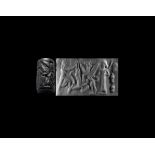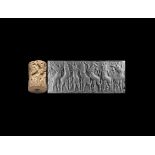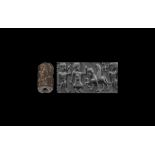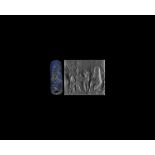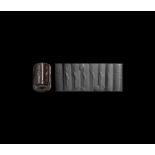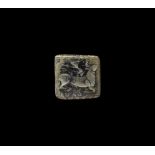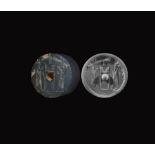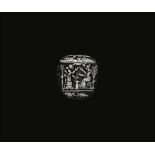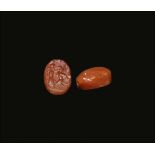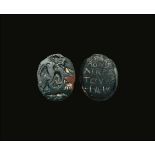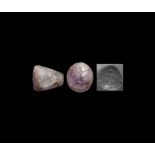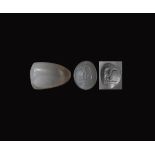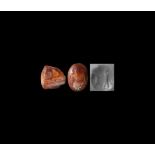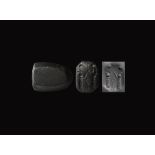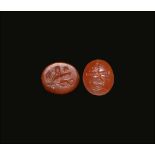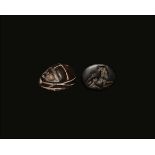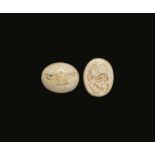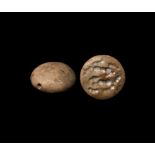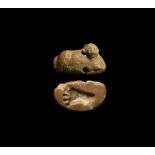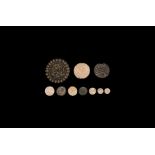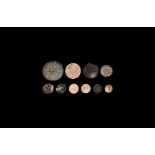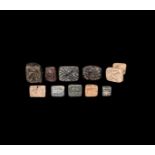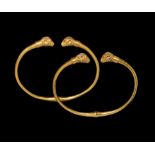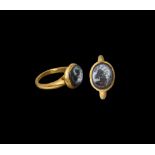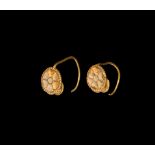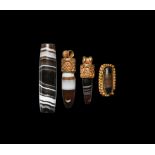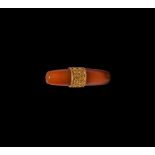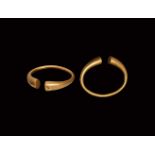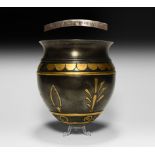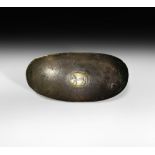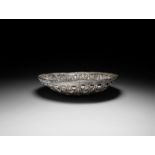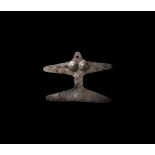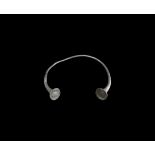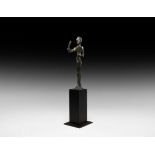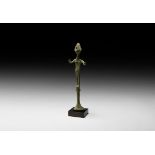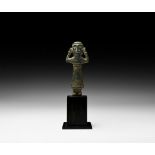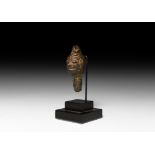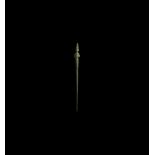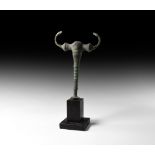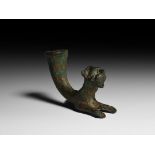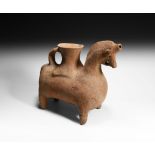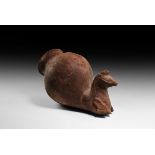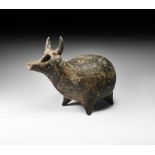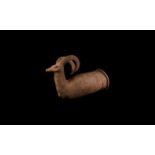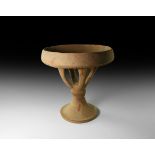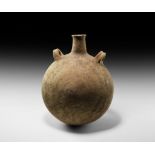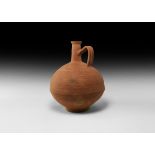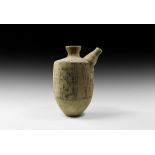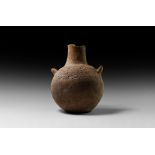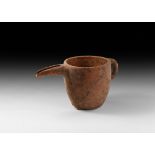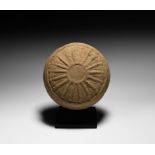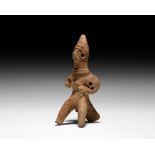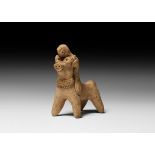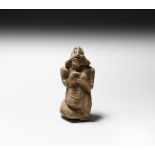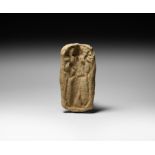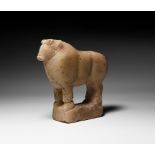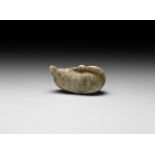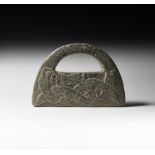Refine your search
Estimate
Category
- Jewellery (132)
- Arms, Armour & Militaria (71)
- Greek, Roman, Egyptian & Other Antiquities (55)
- Chinese Works of Art (52)
- Sculpture (47)
- Collectables (31)
- Metalware (21)
- Ceramics (19)
- Salvage & Architectural Antiques (18)
- Taxidermy & Natural History (17)
- Books & Periodicals (14)
- Coins (14)
- Glassware (12)
- Furniture (9)
- Islamic Works of Art (7)
- Vintage Fashion (6)
- Sporting Memorabilia & Equipment (5)
- Textiles (5)
- Indian Works of Art (4)
- Lighting (4)
- Scientific Instruments (4)
- Musical Instruments & Memorabilia (3)
- Classic Cars, Motorcycles & Automobilia (2)
- Models, Toys, Dolls & Games (2)
- Silver & Silver-plated items (2)
- Ethnographica & Tribal Art (1)
- Prints (1)
- Russian Works of Art (1)
- Stamps (1)
Filtered by:
- Creator / Brand
- List
- Grid
A subscription to the Price Guide is required to view results for auctions ten days or older. Click here for more information
Later 2nd millennium BC. A substantial lapis lazuli cylinder seal with intaglio frieze depicting a helmetted warrior holding up a deer by its hind...
2nd millennium BC. A limestone cylinder seal with intaglio frieze depicting pairs of rearing lions attacking a horned man with rearing ibexes betw...
1st millennium BC. A carved black jasper cylinder seal with a frieze of an advancing lamassu before a standing figure with his right arm raised, h...
2nd millennium BC. A small lapis lazuli cylinder seal with a standing ram before a kneeling figure, symbols above; accompanied by a museum-quality...
2nd millennium BC. A haematite octagonal-section seal with frieze of standing robed figures, two wicket gates(?"). 10.2 grams, 20mm (3/4"). From ...
2nd millennium BC. A glazed composition seal, biconvex in section with intaglio scene of a bull with legs folded beneath the body over tufts of gr...
626-539 BC. A blue-grey chalcedony disc seal with central perforation, intaglio scene of two standing figures in pleated robes facing an altar(?) ...
1st millennium BC. A heater-shaped serpentine stamp seal with pierced lug handle; intaglio scene with seated robed figure and opposed standing rob...
626-539 BC. A carnelian scaraboid with intaglio scene to the underside of a kilted hero gripping the neck of an attacking gryphon; accompanied by ...
3100-2900 BC. An elliptical jasper bifacial intaglio, to the obverse a kneeling human in profile with birds, fish and mammals surrounding, the rev...
626-539 BC. A conical amethyst stamp with intaglio crouching archer drawing his bow. 5.55 grams, 18mm (3/4"). From an important London based coll...
626-539 BC. A conical agate seal with intaglio bust of a lyre player with frond to the rear. 14.04 grams, 28mm (1"). From an important London bas...
626-539 BC. A conical banded agate seal with intaglio crowned figure holding a knife in one hand and gripping the throat of a rearing lion with th...
626-539 BC. A D-shaped haematite seal with intaglio pair of opposed robed figures beneath a crescent moon. 21.2 grams, 26mm (1"). From an importa...
2nd millennium BC. A carnelian scaraboid with intaglio to the flat face of a sphinx with flame(?) beside the chest and star above the folded wing,...
1st millennium BC. A glass scaraboid with segmented upper face, intaglio regardant lion(?) to the underside; accompanied by a museum-quality impre...
2nd millennium BC. A white jasper bifacial scaraboid with intaglio regardant beast to the flat face, faravahar to the domed face; accompanied by a...
31st-29th century BC. A carved plano-convex chert stamp seal, pierced for suspension, the underside with a drilled zoomorphic motif. 40.2 grams, ...
3rd millennium BC. A steatite amulet of a reclining bovine, small head with engraved details to the face, legs tucked under the body; the undersid...
3rd-1st millennium BC. A group of ten seals, including five accompanied by typed and signed notes by the late W.G.Lambert, Professor of Assyriolog...
Mainly 4th-2nd millennium BC. A mixed group of stone plano-convex stamp seals, discoid in plan, including five accompanied by an old scholarly not...
3rd-1st millennium BC. A mixed group of ten stamp seals, including four accompanied by typed and signed notes by the late W.G. Lambert, late Profe...
4th century BC. A matched pair of gold penannular bracelets, each a round-section shank with median carinated bulb, the separate finials a pair of...
3rd-4th century AD. A gold finger ring with D-section hoop, scooped shoulders, ellipsoid bezel with inset nicolo, horse- or stag-head motif. 7.89 ...
6th-4th century BC. A matching pair of gold earrings with hook closure, decorative disc with beaded border and raised petal-shaped cells for inlay...
2nd millennium BC and later. A mixed collection of banded agate beads, most with granulated gold mounts. 3.49 grams total, 11-23mm (1/2 - 1"). Ex...
1st millennium BC. A fusiform carnelian bead with median gold collar, decorated with applied running filigree scroll ornament. 2.24 grams, 24mm (...
6th-4th century BC. A heavy silver-gilt penannular bracelet with slender shank and broad clubbed terminals. 48.05 grams, 60mm (2 1/2"). Property ...
6th-4th century BC. A silver poppy-head vessel with carinated shoulder and flared rim; parcel-gilt D-shaped petals to the shoulder above a gilt ba...
6th-7th century AD. A silver boat-shaped bowl, elliptical in plan with rounded underside, thickened rim, hammered texture; to the centre a profile...
6th-5th century BC. A substantial sheet-silver bowl with central discoid omphalos, three tiers of intersecting raised lotus petals, chamfered rim....
4th-3rd millennium BC. A silver pendant formed as a stylised female figure with splayed limbs, incised notches to the edges, pointillé to the pubi...
2nd millennium BC. A silver round-section penannular bracelet with lion-headed terminals, each head with stylised features, large pellet eyes and ...
2nd millennium BC. A silver neck-ring with round-section shank developing to a trumpet-shaped finial at each end. 319 grams, 19cm (7 1/2"). From ...
3rd-2nd millennium BC. A bronze figure of a nude male standing with legs together, left arm bent and hand placed on the midriff, right arm extende...
Late 2nd millennium BC. A slender bronze figurine of a standing warrior wearing a short kilt, both arms extended and bent at elbow, pierced throug...
2nd millennium BC. A bronze figure of a female worshipper standing, wearing a bell-shaped robe and ribbed girdle, leggings and shoes, bare-chested...
2nd millennium BC. A bronze mount of janiform head of Pazuzu, the king of demons of the wind, fierce expression and wide slit mouth; pierced lug t...
2nd millennium BC. A substantial bronze cloak pin with figural finial, male torso with tiered headdress. 60.3 grams, 21.5cm (8 1/2"). Property of...
13th-6th century BC. A bronze standard finial comprising a ribbed tubular socket with flanged mouth, bulb terminal with lateral spurs each curved ...
1st millennium BC. A bronze rhyton-style vessel with flared cup and lion or lioness finial with extended forelegs. 38.5 grams, 53mm (2"). Propert...
2nd millennium BC. A ceramic rhyton formed as a horse with barrel-shaped body and stub legs, funnel and strap handle to the saddle, curved neck wi...
13th-12th century BC. A terracotta rhyton with bulbous body and flared rim, the spout formed as the foreparts of a horse with applied bridle, stif...
Western Asiatic Bull Rhyton
2nd millennium BC. A ceramic rhyton formed as a bull with globular body and stub legs, short head with horns and annular eyes, U-section spout to ...
1st millennium BC. A terracotta rhyton with tubular body and everted rim, a collar beneath the rim; the finial an ibex head with long curved horns...
13th-6th century BC. A terracotta vessel comprising a trumpet-shaped foot rising to a bulb with four curved arms extending to support a broad bowl...
2nd-1st millennium BC. A substantial ceramic flask with discoid body, short flared spout and two gusseted loop handles to the shoulders. 2.6 kg, ...
3rd-1st century BC. A fine example of a classic terracotta vessel type with bulbous biconical body and applied strap handle, long narrow neck and ...
4th-3rd millennium BC. A ceramic ewer with metope-style painted decoration as a frieze of triglyphs of hatching and straight and curved lines. See...
Ghassulian Culture, 5th-4th millennium BC. A ceramic vase with bulbous body, tubular neck, pierced lug handles to the shoulders, geometric pricked...
13th-12th century BC. A terracotta ewer with barrel-shaped body, loop handle, curved 'beak' spout open above, two small lug feet to the base. 507...
8th century BC. A squat terracotta bowl with flared rim, lotus-flower ornament to the underside. 197 grams, 13cm (5"). Property of a North London...
12th-2nd century BC. A clay figure formed as a male deity, seated, holding applied weaponry beneath his arm and at torso; wearing conical headpiec...
12th-7th century BC. A ceramic figure of a standing bull with a rider on its back holding onto the horns, leaning forwards, staring the bull in th...
5th-4th millennium BC. A ceramic figurine of a nude female squatting on one leg, hands clasped to the chest, with bobbed hair and a collar of two ...
Circa 1800 BC. A terracotta one-piece mould for a low-relief standing figurine of a god, possibly Zababa, standing facing with feet turned, holdin...
2nd century BC-2nd century AD. A carved alabaster figure of a bull on a rectangular base. 839 grams, 13.7cm (5 1/2"). Property of a central London...
2nd millennium BC. A carved alabaster weight in the form of a sleeping duck with erect tail, its head and neck resting along the spine. 10.9 gram...
2nd millennium BC. A carved schist D-shaped weight with a frieze to each broad face: obverse with two entwined serpents enclosing a bird in flight...

